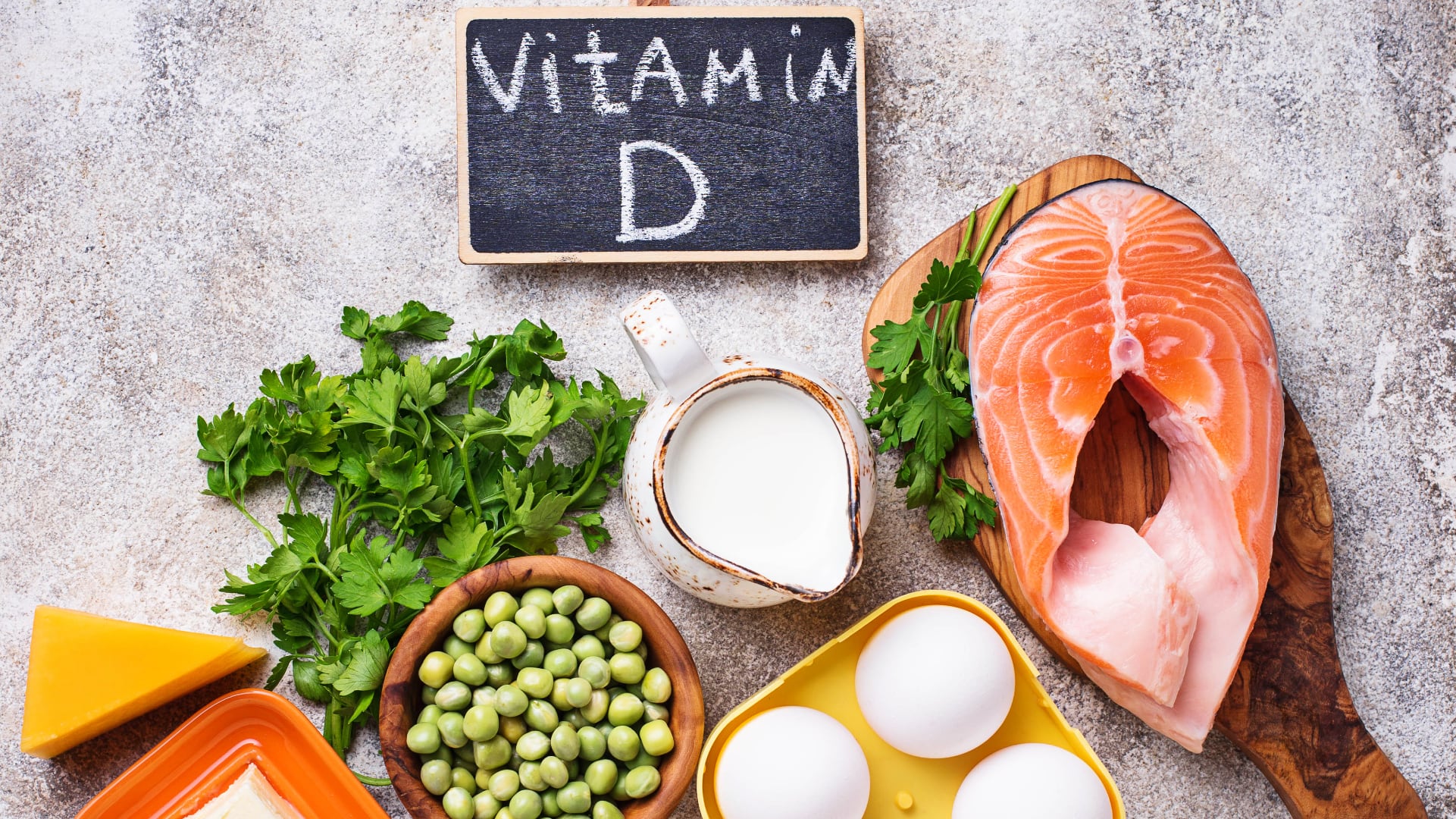Vitamin D is often called the “sunshine vitamin” because our bodies naturally produce it when skin is exposed to sunlight. Unlike most vitamins, it functions more like a hormone, influencing multiple systems in the body. While small amounts can be found in foods such as fatty fish, egg yolks, and fortified dairy products, many people do not get enough from diet or sunlight alone—making supplements and injections important options for maintaining healthy levels.
Why Vitamin D Is Important
Vitamin D plays a central role in many aspects of health:
- Bone health: It helps the body absorb calcium, keeping bones strong and reducing the risk of osteoporosis and fractures.
- Immune function: Adequate levels support the immune system, helping the body defend against infections.
- Mood and energy: Low vitamin D has been linked to fatigue, low mood, and even seasonal affective disorder.
- Muscle strength: It contributes to muscle performance, which is particularly important as we age.
- Overall well-being: Research suggests that vitamin D may also play a role in cardiovascular health, inflammation control, and long-term wellness.
Why Sunlight Alone Is Not Enough, even in Bangkok
It might seem logical to rely on the sun for vitamin D, but science shows that natural sunlight exposure rarely ensures sufficient levels. A 2025 global meta-analysis including over 1.5 million participants found that nearly half of the world’s population (47%) had vitamin D insufficiency (<50 nmol/L), despite varied climates and sunlight availability.
Even in controlled studies, sunlight has proven insufficient. In one trial of Korean adults with deficiency, four weeks of midday sun exposure (30–60 minutes, three times per week in summer) raised vitamin D levels by only 0.9 ng/mL, while a daily supplement of 800 IU raised them nearly fourfold more (+3.5 ng/mL)—and only two participants in the sun group reached minimal sufficiency.
This problem extends even to “sunny” countries. Deficiency rates remain high in the Middle East and the United Arab Emirates, and winter levels in Australia show deficiency in up to 36% of the population (<50 nmol/L). Major health organisations also warn against unprotected UV exposure as a source of vitamin D, since the risks of skin cancer outweigh the modest benefits.
The conclusion is clear: for most people, relying on sunlight alone is not enough to meet vitamin D needs safely or effectively.
Vitamin D Deficiency: Common Symptoms & Signs
Deficiency can be silent. When present, symptoms are often non-specific and overlap with other conditions; medical evaluation is important.
- General: Persistent fatigue, low energy, low mood.
- Musculoskeletal: Achy bones, diffuse muscle pain/weakness, cramps, “heaviness” in legs, worse stair-climbing or getting up from a chair.
- Performance & balance: Reduced exercise tolerance, more frequent falls (especially in older adults).
- Dental/bone health: More fractures with minor trauma, delayed fracture healing; in severe cases, osteomalacia (bone softening) in adults.
- Children (for awareness): Irritability, delayed growth, bowed legs/rickets (severe deficiency).
Note: These symptoms are not unique to vitamin D lack. Testing is the only way to confirm status.
When Should You Get Tested?
Testing is reasonable if you have symptoms, risk factors, or a medical indication. Routine screening in healthy, low-risk adults without symptoms is generally not necessary.
Consider a 25(OH)D blood test if you:
- Have symptoms suggestive of deficiency (see above).
- Have limited sun exposure (indoor work, high-latitude winters, consistent sunscreen/clothing coverage).
- Have darker skin (more melanin reduces vitamin D production).
- Are older (reduced skin synthesis) or pregnant/breastfeeding (higher needs).
- Live with malabsorption or chronic conditions (e.g., celiac/IBD, bariatric surgery, chronic liver/kidney disease).
- Take medications that affect vitamin D metabolism (e.g., anticonvulsants, glucocorticoids, some HIV/TB drugs).
- Have obesity (vitamin D can be sequestered in adipose tissue) or osteoporosis/osteopenia/frequent fractures.
- Are starting, changing, or monitoring therapy (high-dose supplementation or injections).
How to time it
- Baseline: If any of the above apply, obtain a baseline level.
- Re-check:
- After starting or changing supplementation: 8–12 weeks later (vitamin D equilibrates slowly).
- Once stable: every 6–12 months if you remain at risk or on higher doses; otherwise, no regular testing is needed.
Quick result guide (ng/mL)
- < 12 ng/mL: Deficiency—treatment indicated and evaluation for causes.
- 12–19 ng/mL: Likely insufficient—supplement and re-test.
- ≥ 20 ng/mL: Generally adequate for most healthy adults; personalize within 20–40 ng/mL based on risk and bone health.
- > 50–60 ng/mL: Usually unnecessary; discuss dose reduction unless specifically indicated.
- > 150 ng/mL: Potential toxicity, typically with high calcium—urgent clinical review.
Oral Vitamin D Supplements

The most common way to boost vitamin D levels is through oral supplements—available as tablets, capsules, or drops. They are convenient, easy to use daily, and effective for most people. Oral supplements are best for ongoing support and gradual improvement of vitamin D status.
Vitamin D2 vs D3: What’s the Difference and Which Should You Take?
Short answer: Both D2 (ergocalciferol) and D3 (cholecalciferol) can correct low vitamin D, but D3 generally raises and maintains blood levels more effectively for most people. D2 is fully acceptable—especially for strict vegans—yet you’ll often need a bit more or more frequent dosing to achieve the same result.
What they are
- Vitamin D2 (ergocalciferol): Produced by irradiating plant/yeast sterols (ergosterol). Traditionally used in many prescription products (e.g., 50,000 IU capsules).
- Vitamin D3 (cholecalciferol): The form your skin makes from sunlight. Most supplements come from lanolin (sheep’s wool). Vegan D3 (from algae/lichen) is now widely available.
How the body uses them
Both forms are converted in the liver to 25-hydroxyvitamin D [25(OH)D] (what your blood test measures), then in the kidney and other tissues to the active hormone 1,25-dihydroxyvitamin D. The pathways are the same, but:
- D3 binds more tightly to vitamin-D–binding protein → longer half-life in the body.
- Result: Higher and more sustained 25(OH)D levels per dose with D3 in most head-to-head studies.
Practical implications
- Effectiveness: For the average adult, D3 is modestly more potent at raising 25(OH)D and keeping it up between doses.
- Dose planning: If you use D2, expect to need a higher total weekly dose or shorter intervals to match D3’s effect.
- Availability & cost:
- D2 is often the prescription 50,000 IU capsule (which some insurance plans cover).
- D3 is widely available OTC in daily doses (e.g., 1,000–5,000 IU) and weekly/monthly options; vegan D3 exists if needed.
- Dietary preference:
- Strict vegans: Choose D2 or vegan-sourced D3 (algae/lichen).
- Most others: D3 is a straightforward choice.
Safety and toxicity
- Both forms are safe at usual doses and share the same toxicity profile (excessively high, prolonged doses can raise calcium and strain kidneys).
- Toxicity typically occurs with very high intakes over time, not standard maintenance ranges.
Lab testing notes
- Many labs report total 25(OH)D (the sum of 25(OH)D2 + 25(OH)D3).
- If you’re supplementing with D2, don’t be alarmed if your report breaks out 25(OH)D2 and 25(OH)D3 separately; clinicians look at the total.
Which should you choose?
- Default for most adults: D3, because it’s more efficient per IU and maintains levels better.
- Good reasons to choose D2: You’re a strict vegan and can’t find vegan D3, or prescription coverage makes D2 substantially cheaper for you.
- If repleting a marked deficiency: Either works, but many clinicians prefer D3 due to its more durable rise in 25(OH)D.
Typical use (general guidance, not personal medical advice)
- Maintenance: Commonly 800–2,000 IU/day (20–50 µg), often as D3.
- Catch-up/repletion: Your clinician may use weekly high-dose D2 or D3 for a set period, then switch to maintenance; re-test in 8–12 weeks.
Remember your target: For most healthy adults, keeping 25(OH)D ≥ 20 ng/mL (≥ 50 nmol/L) is adequate; many personalise within 20–40 ng/mL based on risks and bone health history. Avoid long-term levels > 50–60 ng/mL unless specifically indicated by your clinician.
Vitamin D Injections (Shots)
For those with significant deficiencies, digestive issues, or difficulty with consistent supplement use, vitamin D injections can be a practical option. These are administered by a healthcare professional and deliver a high dose directly into the muscle. Because vitamin D is stored in body tissues, injections can provide long-lasting effects, sometimes for weeks or months, depending on the dosage. The dosage is typically 300,000 iu.
How to Optimise Safely
- Check your levels: A simple blood test (25-hydroxyvitamin D) will show if you are deficient.
- Everyday supplementation: Many adults benefit from 800–2,000 IU daily, though some may require more under medical guidance.
- When injections make sense: For those with very low levels, absorption issues, or difficulty taking daily pills, an injection may be recommended to restore balance quickly.
- Avoid excess: Very high intakes over time can cause problems, such as high calcium levels and kidney strain—so it is best to follow medical advice.
Final Thoughts
Vitamin D is more than just a nutrient—it is a cornerstone of health, influencing bones, muscles, mood, and immunity. Relying on sunlight is rarely enough to meet the body’s needs, and safe, effective options exist in the form of oral supplements and injections. Checking your levels and discussing them with a healthcare professional ensures that you receive the right approach for long-term wellbeing.
References
- NIH Office of Dietary Supplements. “Vitamin D — Fact Sheet for Health Professionals.”
- National Academies of Sciences, Engineering, and Medicine (Food & Nutrition Board). Dietary Reference Intakes for Calcium and Vitamin D. National Academies Press, 2011.
- Endocrine Society Clinical Practice Guideline. “Vitamin D for the Prevention of Disease.” (Guideline update; Rosen CJ et al., 2024).
- U.S. Preventive Services Task Force. “Screening for Vitamin D Deficiency in Adults: Recommendation Statement.” JAMA, 2021.
- American Academy of Dermatology. “Position Statement: Vitamin D and Ultraviolet Radiation.” (Most recent reaffirmation).
- Tripkovic L., Lambert H., Hart K., et al. “Comparison of vitamin D2 and vitamin D3 supplementation in raising serum 25(OH)D concentrations: a systematic review and meta-analysis.” American Journal of Clinical Nutrition, 2012.
- Cashman K.D., Dowling K.G., Škrabáková Z., et al. “Vitamin D deficiency in Europe: pandemic?” American Journal of Clinical Nutrition, 2016.
- Bouillon R., Marcocci C., Carmeliet G., et al. “Skeletal and extraskeletal actions of vitamin D: current evidence and outstanding questions.” Endocrine Reviews, 2019.
- Vieth R. “Vitamin D supplementation, 25-hydroxyvitamin D concentrations, and safety.” American Journal of Clinical Nutrition, 1999.
- Cancer Council Australia (or comparable national dermatology/oncology body). “Position Statement on Sun Exposure and Vitamin D.” (Current edition).
